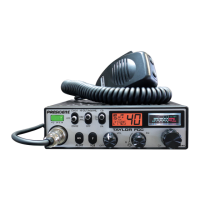
Do you have a question about the PRESIDENT Taylor FCC and is the answer not in the manual?
| Type | CB Radio |
|---|---|
| Channels | 40 |
| Modulation | AM |
| Power Output | 4 Watts |
| Microphone | Electret condenser |
| Power Source | 13.2 V DC |
| Antenna Impedance | 50 Ohms |
| Frequency Range | 26.965 MHz - 27.405 MHz |
Provides a visual overview of the PRESIDENT TAYLOR FCC 12/24 V transceiver and its components.
Emphasizes antenna connection and SWR adjustment before initial use to prevent damage.
Details optimal placement, wiring, and antenna selection/installation for the CB radio.
Explains correct power supply connection, fusing, and the SWR adjustment procedure.
Instructions for power, volume, squelch, ASC, channel selection, and LCD display icons.
Covers CB/PA/Talkback modes, noise filters (NB/ANL/HI-CUT), and emergency channels.
Details VOX transmission, Weather (WX) mode, and the ALERT function.
Information on USB charging, microphone connection, PTT, TOT, and channel scanning.
Guides on navigating menus, selecting functions, and modifying parameters.
How to change LCD color/brightness and configure Key Beep/Roger Beep.
Menu-based SWR adjustment and configuration for special functions.
Setting emergency channels (EMG SET 1/2) and configuring VOX sensitivity, anti-VOX, and delay.
Configuring the Public Address (PA) mode for external speaker output.
Selecting microphone type and performing a factory reset of the transceiver.
Details general specifications, transmission capabilities, and frequency ranges.
Covers reception sensitivity, selectivity, and audio output specifications.
Steps to diagnose and resolve common problems like no transmit or poor reception.
Basic transmission/reception procedures and definitions of terms and codes.
Details warranty period, registration process, and required documentation.
Lists items not covered by warranty and steps for handling malfunctions.
Compliance statements regarding antenna gain and permitted operation from Industry Canada.
Warnings and guidelines for maintaining safe distances from the antenna during operation.
Specifies minimum separation distances for antenna installation and user safety.
States compliance with license-exempt radio standards and operational conditions.